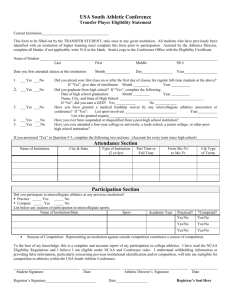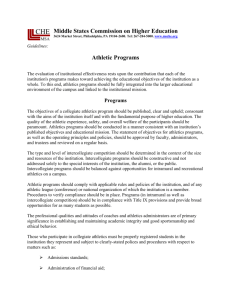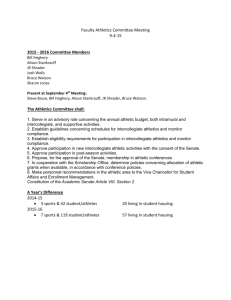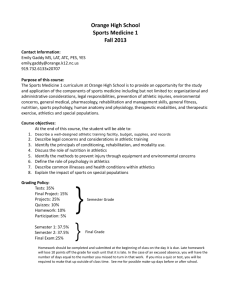Title IX and Its Effect on Men's Collegiate Athletics
advertisement
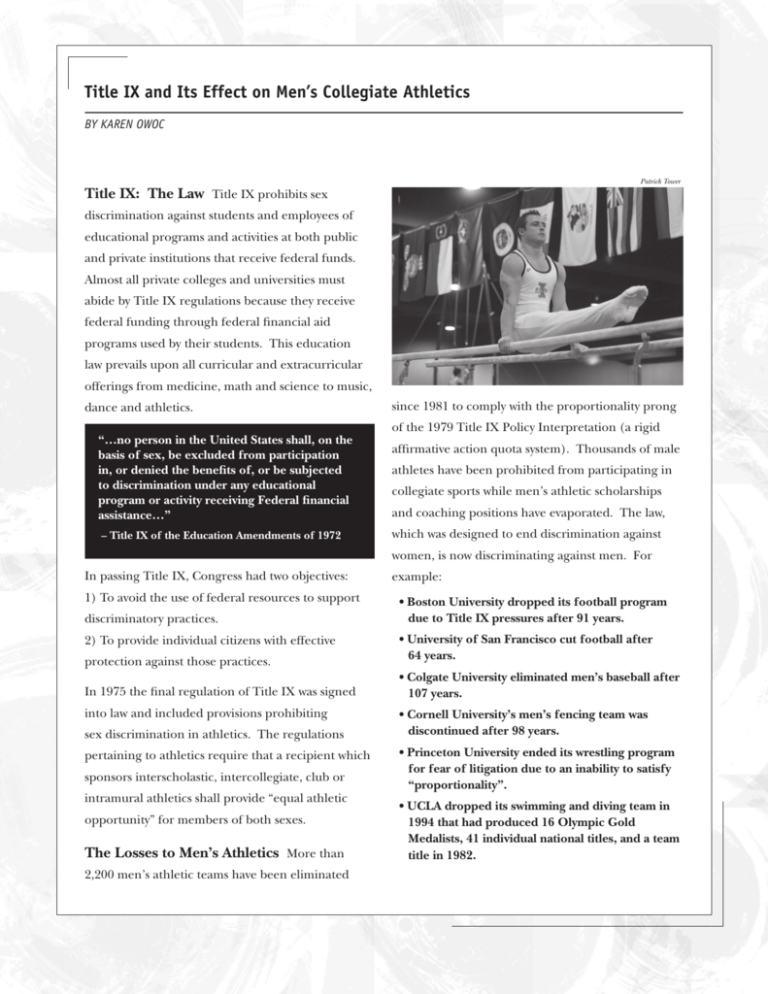
Title IX and Its Effect on Men’s Collegiate Athletics By Karen Owoc Patrick Tower Title IX: The Law Title IX prohibits sex discrimination against students and employees of educational programs and activities at both public and private institutions that receive federal funds. Almost all private colleges and universities must abide by Title IX regulations because they receive federal funding through federal financial aid programs used by their students. This education law prevails upon all curricular and extracurricular offerings from medicine, math and science to music, dance and athletics. “…no person in the United States shall, on the basis of sex, be excluded from participation in, or denied the benefits of, or be subjected to discrimination under any educational program or activity receiving Federal financial assistance…” – Title IX of the Education Amendments of 1972 since 1981 to comply with the proportionality prong of the 1979 Title IX Policy Interpretation (a rigid affirmative action quota system). Thousands of male athletes have been prohibited from participating in collegiate sports while men’s athletic scholarships and coaching positions have evaporated. The law, which was designed to end discrimination against women, is now discriminating against men. For In passing Title IX, Congress had two objectives: example: 1) To avoid the use of federal resources to support • Boston University dropped its football program due to Title IX pressures after 91 years. discriminatory practices. protection against those practices. • University of San Francisco cut football after 64 years. In 1975 the final regulation of Title IX was signed • Colgate University eliminated men’s baseball after 107 years. 2) To provide individual citizens with effective into law and included provisions prohibiting sex discrimination in athletics. The regulations pertaining to athletics require that a recipient which sponsors interscholastic, intercollegiate, club or intramural athletics shall provide “equal athletic • Cornell University’s men’s fencing team was discontinued after 98 years. • Princeton University ended its wrestling program for fear of litigation due to an inability to satisfy “proportionality”. The Losses to Men’s Athletics More than 2,200 men’s athletic teams have been eliminated opportunity” for members of both sexes. • UCLA dropped its swimming and diving team in 1994 that had produced 16 Olympic Gold Medalists, 41 individual national titles, and a team title in 1982. Title IX and Its Effect on Men’s Collegiate Athletics (Cont.) • UCLA abandoned its men’s gymnastics team ten years after it had produced half of the United States team that won the gold medal in the 1984 Olympics. • In the 2000 Summer Olympics, the U.S. sent 338 men and 264 women to compete. In 2004, nearly equal numbers of men and women – an estimated • Since 1982, over 64 schools have discontinued swimming and diving programs. 282 men and 263 women – represented the United • 212 men’s gymnastics teams have been dropped since 1969 (2,544 roster positions lost); only 18 NCAA programs remain (216 roster positions). preview entitled “Female Athletes Continue to • 355 men’s college wrestling teams (22,000 roster positions) have been eliminated over the past decade. • James Madison University dropped men’s archery, indoor track, outdoor track, cross country, gymnastics, swimming and wrestling in 2006. • Rutgers University eliminated men’s light weight crew, heavy weight crew, swimming, tennis, diving, and fencing in 2007. States in 2004. Consider a Washington Post Olympic Gain Ground” written in April 2004. The article celebrated the equality in these numbers as evidence of progress for women, but the number of women competing was essentially unchanged. The so-called victory for women was the elimination of more than 50 male athletes from the U.S. roster. Title IX and Athletics: Equal Athletic Opportunity To help clear up the confusion from the broad proscriptive language of the statute, • Men’s Olympic sports in colleges (such as, Congress directed the Office of Civil Rights (OCR) gymnastics, baseball, swimming, track and field, to provide regulations for the enforcement and water polo, volleyball, soccer, tennis and wrestling) application of Title IX. Thus, the OCR produced are disappearing under pressure to achieve “gender the 1979 Intercollegiate Athletics Policy Interpret- equity” under Title IX. Consequently, the pool ation of Title IX. The Policy Interpretation of U.S. Olympic talent has diminished due to the identified three basic parts (Sections) of Title tremendous loss of men’s Olympic sports in colleges. IX as it applies to equal opportunities in athletic These cuts inevitably affect high school participation programs, whereas institutions must meet all of the in that sport as well. requirements in order to be in compliance with Title For example, in 1969 over 40,000 high school boys IX. These requirements encompass the following: participated in gymnastics in the U.S. with over A. Athletic Financial Assistance (Scholarships) 230 NCAA schools sponsoring men’s gymnastics. Since that time, the sport has lost 92% of its varsity B. Equivalence in Other Athletic Benefits and Opportunities programs (2,544 college roster positions eliminated) C. Effective Accommodation of Student and 75% of its participating boys. Only 18 schools Interests and Abilities Title IX requires sponsoring men’s gymnastics remain today and only “institutions to accommodate effectively two schools exist west of the Rockies - Stanford and the interests and abilities of students to the UC Berkeley. extent necessary to provide equal women or girls recently and over the years, it is probably in opportunity in the selection of sports offered compliance – although only for a period of time. and levels of competition available to members of both sexes”. Title IX does not Accommodation where the institution can require institutions to offer identical sports demonstrate that the interests and abilities of the but an equal opportunity to play. This members of that sex have been fully and effectively section (Section C) has become the focus of accommodated by the present program. the 1979 Title IX Policy Interpretation and its Three-Prong Test. Effective Accommodation of Student Interests and Abilities: The Three-Prong Test The 1979 Intercollegiate Athletics Policy Interpretation of Title IX established three means by which institutions can demonstrate compliance of Section C – Effective Accommodation of Student Interests and Abilities. They are collectively known as the “Three-Prong Effective Accommodation Test” (Three-Prong Test) or alternatively, as the “ThreePart Test”. Compliance by an institution is assessed in any one of the following ways: Prong 1. Substantial Proportionality where intercollegiate level participation opportunities for male and female students are provided in numbers substantially proportionate to their respective fulltime undergraduate enrollments. In other words, if a school is 54% female, about the national average, then about 54% of its athletes should be female. Prong 2. Program Expansion where the institution can show a history and continuing practice of program expansion which is demonstrably responsive to the developing interests and abilities of the underrepresented sex (female students). That means, if a school has added teams for Prong 3. Interest and Abilities The Interpretations of the Three-Prong Test The federal courts’ interpretations of Title IX require women’s interests and abilities to be met at a higher degree than those of men and as a result, a rigid affirmative action quota system was created out of Prong 1 that nullifies men’s equal protection rights. Universities have attempted to comply with Title IX legislation by creating, upgrading or reinstating women’s teams; however, they have done so by eliminating men’s teams. • Many of the courts (Cohen v. Brown University; Roberts v. Colorado State University; Favia v. Indiana University of Pennsylvania) have held that Prong 1 (quota system) of the Three-Prong Effective Accommodation Test carries the most weight in the analysis of compliance. •Many colleges and universities have supposedly “complied” with Prong 1 by essentially cutting men’s teams in order to create the illusion of gender equity (proportionality). This means that many women’s teams have not been helped, but rather, men and men’s teams have been hurt. •Although the OCR enforcement policy does not require or encourage schools to cut men’s teams to establish compliance with Title IX, the federal Title IX and Its Effect on Men’s Collegiate Athletics (Cont.) Patrick Tower courts have set this precedent by versities are ultimately forced to their judicial interpretations and discriminate against men. decisions. In the pivotal, precedent-setting gender-based With revisions in the Policy In- discrimination lawsuit, Cohen terpretation and with additional v. Brown University, the federal clarification, universities can courts’ interpretations of Title comply with Title IX and ac- IX validated the Three-Prong commodate women and men’s Effective Accommodation Test interests to the same degree. promoting a rigid affirmative Eliminating sports was never action quota system which has the intent of Title IX, however, changed how Title IX dictates out of the fear of being non- the way college athletics should compliant, institutions have be run (1996 Clarification of seen no other solution. Intercollegiate Athletics Policy Guidance). It is important to note that gender proportionality is not enforced under Title IX in other educational The Solutions Title IX has become a complex curricular and extracurricular offerings, such as, issue due to the problems that have evolved over its chemistry, economics, drama, or marching band; interpretation. Change requires clarification and therefore, gender ratios should not be engineered redefinition of the Title IX language used in its in sports. Measuring equality through exact pro- Policy Interpretation. It is quite clear that in order portionality (a quota system), as the Cohen courts to save men’s sports programs from further demise, and the Title IX 1996 Clarification suggest, without the Title IX Three-Prong Test must be revised with regard to individual student interests and abilities the law’s original intent restored. is both illogical and discriminatory. Fairness in sports is about effective accommodation, awareness, Conclusion Congress’ intent for the nondiscrimi- and equal opportunity and is first, and foremost, a nation statute has been distorted and it is difficult to human right. embrace such a statute based on the Cohen opinion. Title IX has greatly expanded opportunities for women across the United States, but through misinterpretation and misapplication of the statute and its regulatory tools through courts like Cohen, many uni- Karen Owoc is the Founder and Director of the Pacific Coast Classic. She is also the Co-Founder and Executive Director of Fairness in Sports dedicated to addressing the elimination of collegiate men’s athlete programs. She has two sons who are both involved in sports. www.fairnessinsports.org
